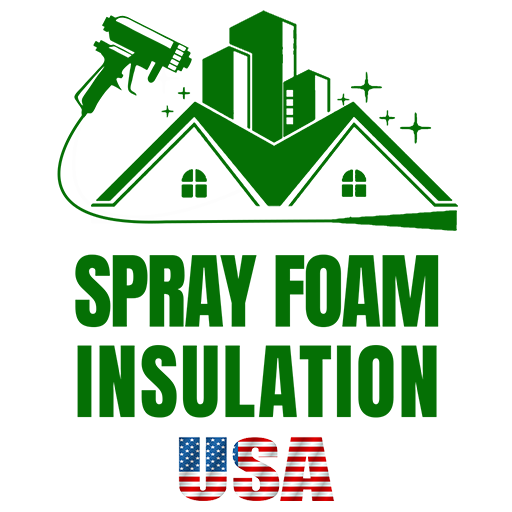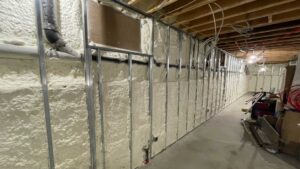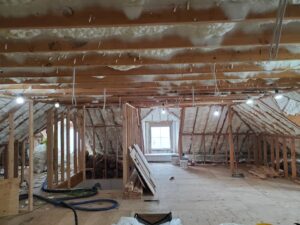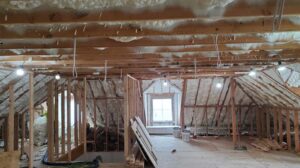Adding insulation to your attic is a straightforward solution for enhancing your home’s energy efficiency and comfort. This simple upgrade can stabilize your indoor climate year-round, reduce heating and cooling costs, and improve the overall livability of your space. Here’s what you need to know quickly:
- Energy Efficiency: Insulation acts as a barrier to heat flow, keeping your home warmer in the winter and cooler in the summer.
- Comfort Improvement: Proper insulation reduces the chances of hot or cold spots in different rooms, providing a uniform temperature throughout your home.
When considering adding insulation to your attic, think about it as putting a thermal blanket over your home. This not only helps in maintaining a comfortable temperature but also reduces the strain on your HVAC system, leading to lower energy bills and a lesser environmental impact.
Spray Foam Insulation USA believes in empowering homeowners and business owners in New York and New Jersey with the knowledge to make their homes more energy-efficient and comfortable. By understanding the importance of attic insulation, you can take a significant step towards creating a greener, more cost-effective living environment.

Evaluating Your Attic’s Current Insulation
Before diving into the project of adding insulation to your attic, it’s crucial to assess the current state of your attic’s insulation. Here are some common signs that indicate your attic may need additional insulation:
Drafty Rooms
If you notice that some rooms feel drafty or have cold drafts during winter, it might be a sign that your attic insulation is insufficient. Drafts often occur when there’s inadequate insulation to maintain a consistent temperature throughout your home.
Uneven Temperature
Do you feel a noticeable temperature difference when moving from one room to another? Uneven heating or cooling in rooms can be a direct result of poor attic insulation. Good insulation helps keep the temperature consistent by preventing heat from escaping in the winter and blocking heat from entering during the summer.
High Bills
An unexpectedly high heating or cooling bill is a red flag that your attic might be under-insulated. Insufficient insulation forces your heating and cooling systems to work harder to maintain the desired temperature, leading to higher energy consumption and, consequently, higher bills.
Ice Dams
In winter, ice dams can form at the edge of your roof when heat from the attic causes snow to melt and then refreeze as it drips off the roof. This can be a sign of excessive heat loss due to inadequate insulation in the attic.
By identifying these issues, you can better understand the need for adding insulation to your attic. Addressing these problems not only enhances comfort but also contributes to energy savings and the overall efficiency of your home. Tackling these issues early can prevent more significant problems in the future and lead to a more comfortable, cost-efficient living environment.
Types of Attic Insulation
When considering adding insulation to your attic, understand the different types available. Each type has unique benefits and installation methods. Let’s explore the most common types: Loose Fill, Batt Insulation, Spray Foam, and Cellulose.
Loose Fill Insulation
Loose fill insulation consists of small particles that are blown into the attic using specialized equipment. This type is ideal for attics with irregular joist spacing or numerous obstructions like pipes and vents because it can conform easily to the space.
Pros:
– Excellent for filling hard-to-reach areas.
– Good for topping up existing insulation.
Cons:
– Requires a blowing machine for installation.
– May settle over time, potentially reducing its effectiveness.
Batt Insulation
Batt insulation comes in pre-cut panels and is commonly made from fiberglass or mineral wool. It’s one of the easiest types to DIY if your attic has standard joist spacing without too many obstructions.
Pros:
– Simple to install; just unroll and fit between joists.
– Provides a moderate barrier against heat and cold.
Cons:
– Not ideal for attics with lots of pipes or irregular framing.
– Gaps can form if not installed correctly, reducing effectiveness.
Spray Foam Insulation
Spray foam is applied wet and expands into a thick foam that hardens. It offers excellent air sealing properties, making it perfect for preventing air leaks in addition to insulating.
Pros:
– Creates an airtight seal that improves energy efficiency.
– Adds structural strength to the attic.
Cons:
– Most expensive option.
– Must be installed by professionals due to the chemicals involved.
Cellulose
Cellulose insulation is made from recycled paper products and is treated with fire retardants. It can be installed as loose fill and is known for its high thermal performance.
Pros:
– Eco-friendly, made from recycled materials.
– Excellent thermal and sound insulation.
Cons:
– Can settle over time, decreasing its effectiveness.
– Requires professional installation for best results.
Each type of insulation has distinct advantages depending on your attic’s specific conditions and your personal preferences. For instance, if you’re looking for an eco-friendly option and don’t mind the additional cost, cellulose might be the way to go. On the other hand, if you need a quick and easy DIY project, batt insulation could be more suitable.
The right choice will help you achieve a balance between cost, effectiveness, and ease of installation. By addressing the need for better insulation, you can enhance your home’s comfort and energy efficiency, leading seamlessly into the benefits these improvements can bring.
DIY vs. Professional Installation
When it comes to adding insulation to your attic, deciding whether to handle it yourself or call in professionals is crucial. Let’s break down the essentials: safety, tools, materials, DIY steps, and when to consider hiring a professional.
Safety Equipment
Safety should be your top priority. Here’s what you’ll need:
– Safety glasses to protect your eyes from dust and debris.
– Gloves to avoid hand injuries and irritation from materials like fiberglass.
– Dust mask or respirator to prevent inhalation of harmful particles.
– Hard hat if you’re working under potentially sharp or heavy objects.
Tools and Materials
The right tools and materials are key to a successful insulation project:
– Insulation material (spray foam, batts, or loose-fill)
– Utility knife for cutting insulation to size
– Measuring tape to ensure accurate insulation placement
– Staple gun (for batt insulation)
– Blower machine (for loose-fill insulation)
DIY Steps
Here’s a simple breakdown for a DIY attic insulation project:
1. Prepare the Attic: Clear out any old insulation if necessary and ensure the space is clean.
2. Seal Air Leaks: Use caulk or spray foam to seal gaps and cracks.
3. Measure and Cut: Measure the space between joists and cut the insulation to fit.
4. Install Insulation: Fit batts between joists or use a blower for loose-fill.
5. Check Ventilation: Ensure soffit vents are not covered to maintain airflow.
When to Hire a Professional
Consider hiring a professional under these circumstances:
– Complex Layouts: If your attic has a lot of corners, wires, or pipes, the installation can get tricky.
– Health Concerns: If you have respiratory issues or allergies, it’s safer to avoid exposure to insulation materials.
– Lack of Time or Tools: Professional installation can be faster and comes with the right equipment.
– Building Codes and Rebates: Professionals ensure compliance with local building codes and can help you qualify for energy rebates.
Hiring a professional can sometimes be more cost-effective when considering the long-term benefits of correctly installed insulation. They have the experience to handle unexpected issues and can ensure that the insulation is applied evenly and safely, covering all nooks and crannies without leaving gaps.
In conclusion, whether you choose DIY or professional installation for adding insulation to your attic, it’s important to consider your ability, health, and the complexity of your attic’s layout. This preparation will help ensure that your home becomes more energy-efficient and comfortable in an effective manner. Now, let’s look into some common mistakes to avoid during this process.
Common Mistakes to Avoid
When it comes to adding insulation to your attic, doing it right the first time saves not only energy but also money and effort in the long run. Here are some critical pitfalls to avoid:
Sealing Air Leaks
Before you even start laying down new insulation, sealing air leaks is a must. Air leaks can undermine the effectiveness of your insulation by allowing warm or cool air to escape. This is particularly crucial around areas like light fixtures, ductwork, and chimney shafts. Use caulk or foam sealants to seal these leaks. “No amount of insulation is going to help if you don’t seal your attic properly,” emphasizes expert Olson.
Not Spreading Evenly
It’s essential to spread insulation evenly across the attic. Uneven insulation can lead to hot or cold spots in your home, reducing overall comfort and efficiency. When using materials like loose-fill cellulose or fiberglass, ensure it’s distributed uniformly, paying close attention to reaching the hard-to-get areas near the eaves.
Covering Ventilation
Your attic needs to breathe. Blocking soffit vents with insulation materials can lead to moisture problems and deteriorate air quality inside your home. Always ensure that vents are not covered and that there’s sufficient airflow to prevent mold and moisture accumulation.
Compressing Insulation
Walking on insulation or storing items on it can compress the material, reducing its insulative properties. If you need to move around in the attic, use a plank to distribute your weight evenly and avoid compressing the insulation beneath your feet.
Incorrect Materials
Using the wrong type of insulation for your specific attic can lead to problems. For instance, installing insulation with a vapor barrier in the wrong orientation can trap moisture, leading to mold growth. Always choose the appropriate insulation type for your climate and attic conditions. Removing the vapor barrier when applying a second layer of fiberglass batt is crucial to prevent moisture issues.
By steering clear of these common errors, you can significantly improve the effectiveness of your attic insulation, leading to better energy efficiency and a more comfortable home environment. Each step in the process is crucial, from sealing leaks to choosing and properly installing the right insulation materials.
Benefits of Adding Insulation to Your Attic
Adding insulation to your attic isn’t just a home improvement; it’s a smart investment. Here’s why focusing on adding insulation to attic can transform your living space and save you money:
Energy Savings
One of the most compelling reasons to add insulation is the reduction in energy costs. Well-insulated attics prevent the loss of warm air during the winter and keep out the heat during summer. This means your heating and cooling systems don’t have to work as hard, which can lead to significant savings on your utility bills. According to the Department of Energy, proper insulation can slash heating and cooling costs by up to 30%. This isn’t just a minor adjustment; it’s a major cut that can add up to substantial savings year after year.
Improved Comfort
Insulation acts like a thermal barrier, maintaining a consistent temperature throughout your home. This barrier helps eliminate problems like drafty rooms and uneven temperatures—common issues in poorly insulated homes. Imagine your home staying cool during the scorching summer days and warm during the chilly winter nights, all without constantly adjusting the thermostat.
Reduced Carbon Footprint
By optimizing your energy use, you’re not only saving money but also helping the planet. Less energy consumption means less reliance on fossil fuels, which leads to lower carbon emissions. Insulating your attic is a straightforward step towards a more sustainable lifestyle, reducing your household’s overall environmental impact.
Prolonged Roof Life
The benefits of attic insulation also extend to your roof. By maintaining a more stable temperature in the attic, insulation prevents the extreme temperature cycles that can lead to roof damage over time. In winter, it can help prevent ice dams—a common issue that not only damages roofs but can also lead to costly water leakage inside your home.
By adding insulation to your attic, you’re not just enhancing your home’s energy efficiency; you’re also improving your living comfort, reducing your environmental impact, and extending the lifespan of your roof. These improvements make a compelling case for why this project is not just beneficial but essential for any homeowner looking to optimize their home’s performance and value.
FAQs About Adding Attic Insulation
Is Adding Insulation Worth It?
Absolutely! Adding insulation to your attic is one of the most cost-effective ways to enhance your home’s energy efficiency. Proper insulation can significantly reduce your heating and cooling costs—by up to 15 to 25 percent according to some estimates. It also improves indoor comfort by maintaining a consistent temperature, reducing the burden on your HVAC system and potentially prolonging its life.
Can I Install Over Old Insulation?
Yes, you can install new insulation over old insulation, unless the old material is damp, moldy, or contaminated with pests. If the existing insulation is in good condition, adding a new layer on top can boost your home’s thermal resistance. However, it’s crucial to choose the right type of insulation for the top layer. For instance, spray foam applied over older batts can seal air leaks effectively, enhancing the overall insulation performance.
How Much Insulation Do I Need?
The amount of insulation you need depends on several factors, including your geographic location, the type of HVAC system you have, and your home’s existing insulation. Generally, attics should be insulated to R-38, which can be around 10 to 14 inches of insulation material, depending on the type used. It’s essential to ensure that the insulation covers all areas evenly, without gaps or compression, to maximize its effectiveness.
By addressing these common questions, homeowners can make informed decisions about adding insulation to attic areas, ensuring they achieve optimal energy efficiency and comfort in their homes. Moving forward, it’s pivotal to consider both the material and method of installation to maximize the benefits of your insulation upgrade.
Conclusion
As we wrap up our comprehensive guide on adding insulation to attic spaces, it’s clear that the choice of insulation material and the precision of the installation process are crucial for enhancing your home’s energy efficiency and comfort. At Spray Foam Insulation USA, we specialize in delivering top-tier attic spray foam insulation solutions that cater specifically to these needs.
Why Choose Spray Foam Insulation USA? Our spray foam insulation not only offers superior thermal resistance but also forms an airtight seal that traditional materials can’t match. This seal minimizes air leakage, which is a common culprit for energy loss in homes. By choosing spray foam, you’re investing in a solution that will keep your home warm in the winter and cool in the summer, reducing your heating and cooling costs significantly.
Moreover, the durability of spray foam means that it maintains its effectiveness over time, unlike other insulation types that may settle or degrade. This longevity makes spray foam a cost-effective option in the long run, as it reduces the need for repairs or replacements.
At Spray Foam Insulation USA, we understand that each home has unique needs. That’s why we offer personalized consultations to ensure that our insulation strategy aligns perfectly with your specific requirements. Our expert team is committed to providing a seamless installation process, ensuring that every nook and cranny of your attic is covered, without any gaps or overlaps.
Sustainability and Comfort go hand-in-hand with our spray foam insulation. Not only does it help reduce your carbon footprint by lowering energy usage, but it also enhances the overall comfort of your living environment. Say goodbye to drafty rooms and fluctuating temperatures, and welcome a more consistent, enjoyable home atmosphere.
Ready to transform your attic and make a lasting impact on your home’s efficiency and comfort? Contact Spray Foam Insulation USA today for a free estimate, and let us guide you through every step of the process. With our expertise and commitment to quality, your attic insulation project is guaranteed to be a success, making your home the best it can be.





